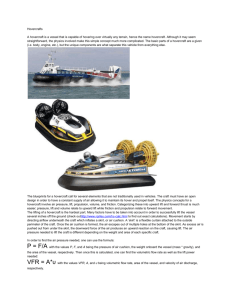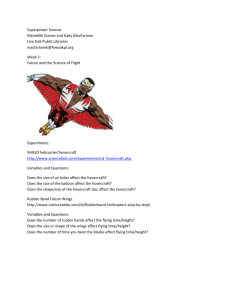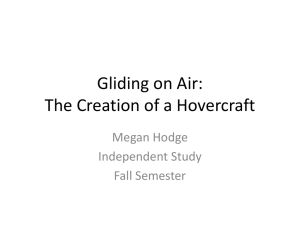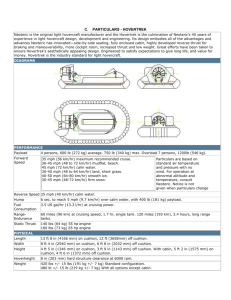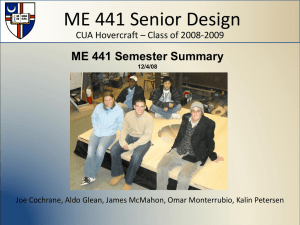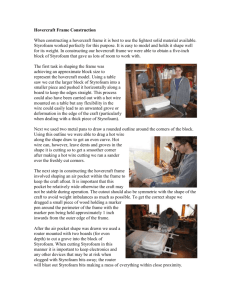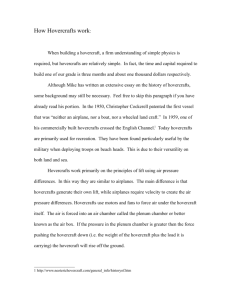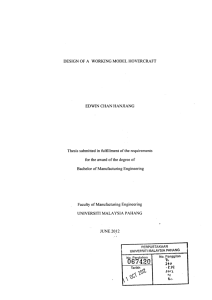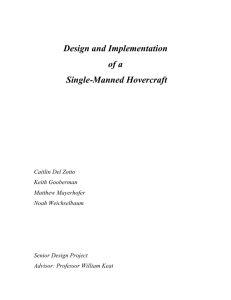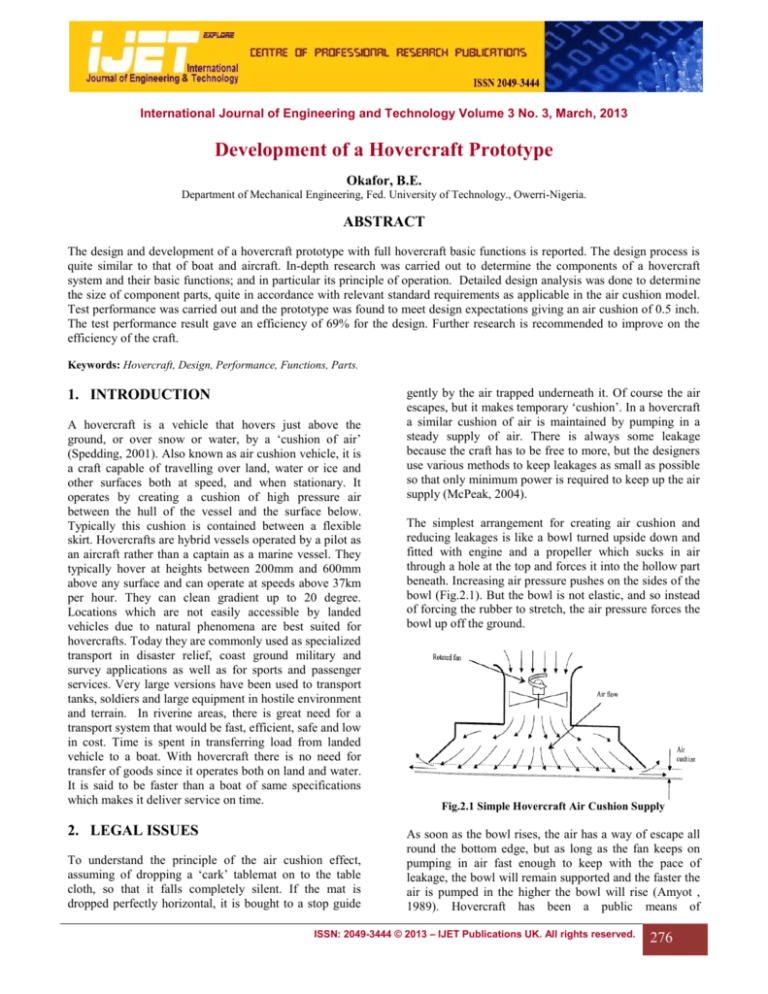
International Journal of Engineering and Technology Volume 3 No. 3, March, 2013
Development of a Hovercraft Prototype
Okafor, B.E.
Department of Mechanical Engineering, Fed. University of Technology., Owerri-Nigeria.
ABSTRACT
The design and development of a hovercraft prototype with full hovercraft basic functions is reported. The design process is
quite similar to that of boat and aircraft. In-depth research was carried out to determine the components of a hovercraft
system and their basic functions; and in particular its principle of operation. Detailed design analysis was done to determine
the size of component parts, quite in accordance with relevant standard requirements as applicable in the air cushion model.
Test performance was carried out and the prototype was found to meet design expectations giving an air cushion of 0.5 inch.
The test performance result gave an efficiency of 69% for the design. Further research is recommended to improve on the
efficiency of the craft.
Keywords: Hovercraft, Design, Performance, Functions, Parts.
1. INTRODUCTION
A hovercraft is a vehicle that hovers just above the
ground, or over snow or water, by a ‘cushion of air’
(Spedding, 2001). Also known as air cushion vehicle, it is
a craft capable of travelling over land, water or ice and
other surfaces both at speed, and when stationary. It
operates by creating a cushion of high pressure air
between the hull of the vessel and the surface below.
Typically this cushion is contained between a flexible
skirt. Hovercrafts are hybrid vessels operated by a pilot as
an aircraft rather than a captain as a marine vessel. They
typically hover at heights between 200mm and 600mm
above any surface and can operate at speeds above 37km
per hour. They can clean gradient up to 20 degree.
Locations which are not easily accessible by landed
vehicles due to natural phenomena are best suited for
hovercrafts. Today they are commonly used as specialized
transport in disaster relief, coast ground military and
survey applications as well as for sports and passenger
services. Very large versions have been used to transport
tanks, soldiers and large equipment in hostile environment
and terrain. In riverine areas, there is great need for a
transport system that would be fast, efficient, safe and low
in cost. Time is spent in transferring load from landed
vehicle to a boat. With hovercraft there is no need for
transfer of goods since it operates both on land and water.
It is said to be faster than a boat of same specifications
which makes it deliver service on time.
2. LEGAL ISSUES
To understand the principle of the air cushion effect,
assuming of dropping a ‘cark’ tablemat on to the table
cloth, so that it falls completely silent. If the mat is
dropped perfectly horizontal, it is bought to a stop guide
gently by the air trapped underneath it. Of course the air
escapes, but it makes temporary ‘cushion’. In a hovercraft
a similar cushion of air is maintained by pumping in a
steady supply of air. There is always some leakage
because the craft has to be free to more, but the designers
use various methods to keep leakages as small as possible
so that only minimum power is required to keep up the air
supply (McPeak, 2004).
The simplest arrangement for creating air cushion and
reducing leakages is like a bowl turned upside down and
fitted with engine and a propeller which sucks in air
through a hole at the top and forces it into the hollow part
beneath. Increasing air pressure pushes on the sides of the
bowl (Fig.2.1). But the bowl is not elastic, and so instead
of forcing the rubber to stretch, the air pressure forces the
bowl up off the ground.
Fig.2.1 Simple Hovercraft Air Cushion Supply
As soon as the bowl rises, the air has a way of escape all
round the bottom edge, but as long as the fan keeps on
pumping in air fast enough to keep with the pace of
leakage, the bowl will remain supported and the faster the
air is pumped in the higher the bowl will rise (Amyot ,
1989). Hovercraft has been a public means of
ISSN: 2049-3444 © 2013 – IJET Publications UK. All rights reserved.
276
International Journal of Engineering and Technology (IJET) – Volume 3 No. 3, March, 2013
transportation in Europe since 1960’s. Every load of the
vehicle is supported by volume air underneath. All
movement and motion is generated by either aerostatic or
aerodynamic force or both. A well designed hovercraft is
superior to boat over water because it has less drag and
requires less horsepower to push it. This results in higher
speeds and better fuel consumption. The hovercraft gets
about twice the fuel mileage of a boat with similar size
and capacity (Nakamura et al, 1997). It gives a smoother
ride than a boat because it maneuvers above the water, not
on it. It travels over water with no concern for depth or
hidden obstacles. It will go against the current of river at
the same ground speed as going along the current. The
hovercraft also works very well in rapids or water where
standing waves up to a meter high have been encountered
for a medium scaled hovercraft (Kerrington, 2011).
3. DESIGN CONCEPT
Figures 3.1 and 3.2 show the assembly and orthographic
views of the hovercraft respectively. Table 3.1 shows the
parts list.
12
Lift system
1
3.1 Principle of Operation
The hovercraft floats above the ground surface on a
cushion of air supplied by the lift fan. The air cushion
makes the hovercraft essentially frictionless. Air is blown
into the skirt through a hole by the blower as shown in
Fig.3.3.The skirt inflates and the increasing air pressure
acts on the base of the hull thereby pushing up (lifting) the
unit. Small holes made underneath the skirt prevent it
from bursting and provide the cushion of air needed. A
little effort on the hovercraft propels it in the direction of
the push. Fig.3.4 shows how pressure is developed in the
skirt.
Table3.1 Component Parts of the Hovercraft
Item
Description
Qty
1
2
3
4
5
6
7
8
9
10
11
The hull base
Lift duct
Seat assembly
Thrust duct assembly
Thrust engine and fan assembly
The skirt
Stand
Rudder
Body cover front
Seat assembly main
Lift engine mount
1
1
1
1
1
1
1
2
1
1
1
Fig.3.3 Blower/Skirt Arrangement
As soon as the assembly floats, a blower incorporated in
the thrust engine blows air backwards which provides an
equal reaction that causes the vehicle to move forward.
Little power is needed as the air cushion has drastically
reduced friction. Steering effect is achieved by mounting
rudders in the airflow from the blower or propeller. A
change in direction of the rudders changes the direction of
air flow thereby resulting in a change in direction of the
vehicle (Fig.3.5). This is achieved by connecting wire
cables and pulleys to a handle. When the handle is pushed
it changes the direction of the rudders.
ISSN: 2049-3444 © 2013 – IJET Publications UK. All rights reserved.
277
International Journal of Engineering and Technology (IJET) – Volume 3 No. 3, March, 2013
Fig.3.4 Pressure Distribution in the Skirt
Fig.3.5 Change in Direction of Rudders
3.2 Description
4. DESIGN OF MAJOR COMPONENTS
The hovercraft works on air cushion. Air cushion is
provided through a blower which pumps air into the skirt
thereby inflating the skirt. The air pressure thus raises the
craft up above the ground. The vehicle has two engines;
the rear and the front. A stator fan is attached to the front
or lift engine which directs air into the skirt to provide air
pressure needed to lift the craft. The propeller attached to
the rear or thrust engine develops the thrust needed to
propel the craft. The propeller is enclosed by the thrust
duct which makes it possible to direct the air. The duct is
bell-shaped such that it increases the velocity of air
escaping the duct. The polyester skirt is PVC coated
which gives it more strength to sustain the air pressure. It
is made air tight. The hull is a platform which sustains the
entire weight of the craft. A hole is made on the hull
through which air enters the skirt.
4.1 The Hull
For demonstration purposes, let the craft be designed to
carry one person of weight 70kg + 15% of 70kg = 80.5kg
Let length of hull = twice the width
If width =1.22m; length =2W= 2.44m; Surface Area =
1.22 X 2.44 = 2.98m 2
Width = 1.22m = 4 feet;
length = 2.44m = 8feet
Material of construction is plywood
4.1.1
Centre of Gravity
Dead weights of components resting on the hull are as
follows.
ISSN: 2049-3444 © 2013 – IJET Publications UK. All rights reserved.
278
International Journal of Engineering and Technology (IJET) – Volume 3 No. 3, March, 2013
Key
A
B
C
D
E
Description
Lift Engine 8.98kg and fan 1kg
Weight (kg)
9.98
Pilot
15.5kg 5hp, 3800rpm thrust engine, 3kg
Propeller cover
Weight of Hull
¼ Inch plywood density= 3.47kg/m2 (www.rfcafe.com)
Area of plywood =2.98m2; Mass = 3.47 x 2.98 =10.34kg
80.5
18.5
3
10.34
Total
The location of the weights relative to the centre of gravity is very important for stability of the hull.
Key
A
B
C
D
E
Total
Weight, (N)
97.90
789.71
181.49
29.43
101.44
1199.97
X(m)
0.61
o.61
0.61
0.61
0.61
XW = XW, X =
, x=
= 0.61m
YW = YW, Y =
, Y=
= 1.71m
4.2 The Lift System
In general, air cushion vehicles use two design
configurations namely the plenum chamber and the
peripheral jet (Paik et al, 2005). Using the peripheral jet
design configuration (Fig.4.1) and under equilibrium
conditions;
Y(m)
0.61
1.80
2.06
2.31
1.22
XW(Nm)
59.72
481.72
110.71
17.95
61.89
731.98
122.32 kg
YW(Nm)
59.72
1421.48
373.87
67.98
123.76
2046.81
Lj = the nozzle perimeter;
T j = the thickness of the
jet/nozzle width
Hj = the lift height;
Rar= the average radius of the
curvature of the length
Pcu = the cushion pressure ; Acu = Cushion area
Qj =total volume flow; Paj=the power required (lift power)
Pajmin= min. lift power;
j = the angle of the nozzle from the horizontal
Let max. weight of pilot = 80.5kg;
also weight of craft = 150kg (total weight on the hull
excluding the pilot)
Fig.4.1 Geometry of peripheral jet system
Weight of craft, w = Lift force, Fcu
Let the nozzle angle to the horizontal = 71.2 0 ;
lift height = 0.2m = hj
Fcu = w = PcuAc + Jj Lj Sin j (Paik et al, 2005)
Thickness of jet = 24 inch = 0.6096 = tj = orifice diameter
Where
Weight force of craft and pilot, W = mg = (150+80.5) kg
x 9.81/s2 =2261.2N = Fcu
Jj = the momentum flux of the air jet per unit length of
the nozzle
Cushion Area, Acu = L x W = 2.44 x 1.22 = 2.98m2
Fcu = W = Pcu Acu + Jj Lj sin j
ISSN: 2049-3444 © 2013 – IJET Publications UK. All rights reserved.
Let the
Eqn. (1)
279
International Journal of Engineering and Technology (IJET) – Volume 3 No. 3, March, 2013
Jj = Pcu x rav
Lift force, Fcu = 2158.2N
Thrust force =2158.2/2 = 1079.1N = Horizontal force
acting on the rudder
= 0.1513 ;
Where hj = 0.2m; Jj = 0.1513 Pcu
But Force = ma; a = 1079.1/1199.97 = 0.9m/s2
Lj = x tj = x 0.6096=1.9151
Acceleration, a =
Substituting in equation (1); 2158.2= P cu 2.98 + (0.1513
Pcu x 1.9151 x sin 71.2
= 2.98 Pcu + 0.2743 Pcu= 3.2543 Pcu; Pcu = 694.8N/m 2
The expression relating the cushion pressure P cu & the
total Pressure of the jet Pj is given by;
Let time =10secs; Change in speed = 9.0 m/s = 32.4km/hr
5. PERFORMANCE TEST
Classical method was used to establish the speed of the
craft.
Distance covered=100m; Speed of craft=100/16.1=6.21 m/s
= 1 – e- 2tj/ra
Eqn. (2)
Pcu/Pj = 1- 3.1641 x 10-4;
695N/m2
(Paik et al, 2005)
Pj = Pcu/[1-3.1641 x10 -4] =
Total volume flow Qj (i.e. air flow rate by volume) is
given by;
Qj =
=
√
(
√
(
√
⁄ )
√
⁄
Eqn. (3)
Designed speed = 9m/s; Efficiency=(6.21/9 ) x 100 = 69%
5.1 Result
The hovercraft was lifted and was propelled by the thrust
system. It was able to carry one person of weight 75kg
and hovered with an air cushion of 0.5 inch.
Maneuverability was achieved with the steering system.
6. CONCLUSION
The craft principle has been demonstrated using low cost
material and has proved capable as a viable means of
transport both on land and water after series of tests. The
propulsion and lifting systems gave excellent performance
and with good maneuverability.
)
(i.e. assuming dry air density = 1.2754 kg/m 3 );
7. RECOMMENDATION
Qj = 9.1776m 3 /s
Power required is given by;
Paj = Pj x Qj = 666.410 x 9.1776 = 6,116.044 watts =
6.116 KW
More research is recommended to improve on the
efficiency of the hovercraft. The skirt has to be air-tight
without leakage.
4.3 The Skirt
The skirt must be able to sustain the pressure needed and
also push the craft up.
The cushion pressure = 694.8 N/m 2
Area of skirt = Cushion area = 2.98m 2 ; Height of lift hj =
0.2m
Thus, Volume of skirt = Area x height of lift = 2.98 x
0.2m = 0.596m 3
4.4 The Thrust System
Less force is needed to thrust the craft and it is normal to
assume that thrust equals half of lift force (Paik , 2004).
ISSN: 2049-3444 © 2013 – IJET Publications UK. All rights reserved.
280
International Journal of Engineering and Technology (IJET) – Volume 3 No. 3, March, 2013
REFERENCES
[1] Amyot J. R. (1989). Hovercraft Technology,
Economics and Applications. Elsevier Science
Publishing Co., New York.
[2] Kerrington
E.
(2011).
Hovercraft.
http://www.kerringtontyler.blogspot.com
[3] McPeak
M. (2004).
History of Hovercraft.
http://hovertron.tripod.com/images/mpaper.pdf
[4] Nakamura H, Kayanuma H, Kimura S, Kosugi M
(1997). A new process for small boat production. J.
Mater. Proc. Technol. pp196-205.
[5] Paik JK, Duran A (2004). Ultimate strength of
aluminum plates and stiffened panels for marine
applications. Mar. Technol., 41(3).
[6] Paik JK, Veen SV, Collette ADM (2005). Ultimate
compressive strength design methods of aluminum
welded stiffened panel structures for aerospace
marine and land-based applications: A benchmark
study. Proc.Thin-Walled Structures. pp 1550-1566.
[7] Spedding S.G. (2001). History of Hovercraft.
http://www.hovercraft.org.uk
ISSN: 2049-3444 © 2013 – IJET Publications UK. All rights reserved.
281


